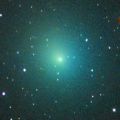
|
It is brightening much faster than expected. It is so bright as 5.7 mag (May 24, Marco Goiato). The apparent size is so large as 20 arcmin. It will pass 0.85 A.U. from the sun in late June, and it may reach up to 4.5 mag. In the Northern Hemipshere, it is unobservable for one month and a half from late May. But it will appear in the morning sky again at 5.5 mag in early July, then it keeps observable after that while the comet is fading gradually. In the Southern Hemipsphere, it keeps observable all the period until the comet fades out, although it will be low in mid June.
Date(TT) R.A. (2000) Decl. Delta r Elong. m1 Best Time(A, h)
May 24 9 5.41 -25 0.8 0.271 1.031 86 5.8 18:28 (110, 67)
May 31 8 14.36 -25 25.9 0.239 0.966 71 5.2 18:26 ( 93, 52)
|

|
Great outburst occured on Oct. 24, and it bacame a naked eye comet of 2 mag. It still keeps so bright as 5.5 mag on Apr. 30 (Carlos Labordena). Now it is extremely faint and difficult to see. It was completely stellar just after the outburst. Then the coma had spread out and now it looks like a huge nebula. The coma diameter has increased up to about 90 arcmin in December and January. But now it is going away from the earth, and the diameter reduced to about 60 arcmin. Now it is getting lower and lower rapidly in the evening sky. It will be unobservable soon. But it will become observable in good condition in autumn again.
Date(TT) R.A. (2000) Decl. Delta r Elong. m1 Best Time(A, h)
May 24 6 1.55 34 57.9 4.180 3.335 29 5.7 18:28 (130, -5)
May 31 6 12.84 34 39.4 4.252 3.364 25 5.8 18:26 (128, -7)
|
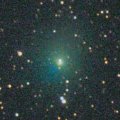
|
It reached up to 9.5 mag on Mar. 29 (Maik Meyer). Now it is fading slowly. It has already faded down to 10.7 mag (May 11, Marco Goiato). Diffuse object with a weak condensation. In the Northern Hemisphere, it will be unobservable soon, then it will never be observable again. In the Southern Hemisphere, it keeps observable until it fades out.
Date(TT) R.A. (2000) Decl. Delta r Elong. m1 Best Time(A, h)
May 24 7 8.88 -0 43.5 1.796 1.383 49 11.0 18:28 (113, 31)
May 31 7 23.38 -4 25.0 1.863 1.428 49 11.2 18:26 (108, 31)
|
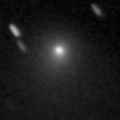
|
Now it is bright as 10.9 mag (May 11, Marco Goiato). It will keep 11 mag for a long time until August. In the Southern Hemisphere, it keeps observable in good condition until summer. In the Northern Hemisphere, the altitude will never be higher than 30 degrees in the evening sky, and the comet will be unobservable in July. It will appear in the morning sky again at 13 mag at the end of 2008, then it keeps bright and observable for a while.
Date(TT) R.A. (2000) Decl. Delta r Elong. m1 Best Time(A, h)
May 24 10 9.26 -17 31.9 2.481 2.796 97 11.2 18:28 (159, 71)
May 31 10 18.17 -15 22.3 2.552 2.786 92 11.3 18:26 (151, 68)
|
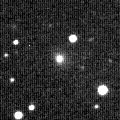
|
It is already very bright as 10.7 mag (May 14, Marco Goiato). It is expected to be 7 mag in September, but it is getting brighter than expected. However, it keeps moving in the southern sky, and it is unobservable for a while in the Northern Hemisphere. It will appear in the evening sky at 7 mag in late September, but it keeps locating in the evening low sky until the end of 2008 when it fades out down to 10 mag. Then it turns to appear in the morning sky, and it keeps observable in the northern sky after that while fading gradually. In the Southern Hemisphere, it keeps observable until late October after this.
Date(TT) R.A. (2000) Decl. Delta r Elong. m1 Best Time(A, h)
May 24 5 48.05 -33 48.9 2.547 2.220 59 11.5 18:28 ( 69, 32)
May 31 5 57.39 -33 58.0 2.468 2.138 59 11.3 18:26 ( 67, 29)
|

|
It will reach to 11 mag in summer. It must have already brightened up to 14 mag, but the comet was not observed recently. The condition in this apparition is bad. In the Southern Hemisphere, it keeps extremely low, or under the horizon, so it will not be observable. In the Northern Hemisphere, it is not observable until August when it appears in the morning sky at 11 mag. After August, it keeps observable and fading in the morning sky.
Date(TT) R.A. (2000) Decl. Delta r Elong. m1 Best Time(A, h)
May 24 3 0.81 2 9.3 2.383 1.517 24 12.0 5:25 (264, 5)
May 31 3 20.43 4 41.7 2.344 1.483 24 11.8 5:29 (260, 6)
|
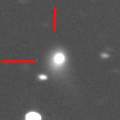
|
It brightened up to 13.5 mag and became visible visually in 2007 autumn (Nov. 13, Juan Jose Gonzalez). It had been unobservable for a while, but now it is appearing in the morning sky. Now it is 13.0 mag (Apr. 27, J. Broughton), brightening as expected. It will reach to 10.5 mag and will be observable in good condition in 2008 autumn. It keeps observable, visible visually, brighter than 14 mag for one year until 2009 May.
Date(TT) R.A. (2000) Decl. Delta r Elong. m1 Best Time(A, h)
May 24 1 3.05 28 6.9 3.408 2.735 41 12.0 5:25 (225, 10)
May 31 1 15.55 30 6.7 3.327 2.702 44 11.9 5:29 (221, 11)
|
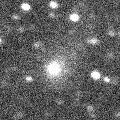
|
Now it is 13.0 mag, already visible visually (May 12, Juan Jose Gonzalez). It will be bright at 12 mag for a long time from 2008 spring to 2009 spring. However, it is only observable until August in the Northern Hemisphere because the comet moves southwards. It keeps observable for a long time in the Southern Hemisphere.
Date(TT) R.A. (2000) Decl. Delta r Elong. m1 Best Time(A, h)
May 24 17 43.00 -15 2.7 2.269 3.219 155 12.4 1:37 (180, 70)
May 31 17 31.23 -16 59.8 2.189 3.180 165 12.2 0:58 (180, 72)
|
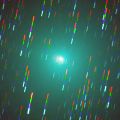
|
It passed near by Earth in early January, and it became a bright large object at 5.4 mag (Jan. 3, Seiichi Yoshida). It was visible with naked eyes. Now it is fading rapidly. It has already faded down to 11.3 mag (May 10, Marco Goiato). It will be fainter than 13 mag in late May. It has already moved away towards the southern sky, and it is no longer observable in the Northern Hemisphere. In the Southern Hemisphere, it keeps observable until it fades out.
Date(TT) R.A. (2000) Decl. Delta r Elong. m1 Best Time(A, h)
May 24 9 5.28 -61 52.9 1.465 1.941 101 12.4 18:28 ( 21, 60)
May 31 9 41.16 -60 32.2 1.528 2.013 102 12.8 18:26 ( 21, 61)
|
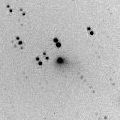
|
New comet. It is bright as 12.3 mag, and visible visually (May 12, Juan Jose Gonzalez). In the Northern Hemisphere, it keeps observable at 12-13 mag for a long time after this until autumn. It will move near by the Northern Pole from summer to autumn, and will be observable all night. Then it keeps observable until 2009 spring when the comet becomes faint. In the Southern Hemisphere, it is only observable until mid June.
Date(TT) R.A. (2000) Decl. Delta r Elong. m1 Best Time(A, h)
May 24 21 26.13 27 44.1 1.572 1.845 88 12.6 5:19 (180, 27)
May 31 21 33.38 34 5.7 1.519 1.816 89 12.5 4:58 (180, 21)
|

|
New comet. Bright, but extremely diffuse. It will approach to the sun down to 0.45 A.U. on June 19. So it will brighten very rapidly after this. In the Northern Hemisphere, it will be observable at 13 mag in the morning low sky from early June to mid June. Then it will never be observable again. In the Southern Hemisphere, it is observable only until late May.
Date(TT) R.A. (2000) Decl. Delta r Elong. m1 Best Time(A, h)
May 24 0 33.31 16 54.8 0.757 0.781 49 14.3 5:25 (227, 23)
May 31 1 36.46 33 37.0 0.734 0.658 40 13.5 5:29 (222, 6)
|
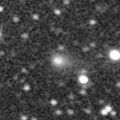
|
New comet. It is bright as 12.7 mag, and visible visually (May 12, Juan Jose Gonzalez). It keeps observable in good condition until autumn. But it is moving southwards gradually, and the altitude will be getting somewhat lower in the Northern Hemisphere. The calculation says it keeps bright at 13 mag for a while. However, it can be in a temporary outburst now, and it may be a very faint short periodic comet originally. It may fade out very rapidly after this.
Date(TT) R.A. (2000) Decl. Delta r Elong. m1 Best Time(A, h)
May 24 16 55.83 -14 10.3 1.460 2.455 166 13.5 0:50 (180, 69)
May 31 16 50.38 -14 31.2 1.452 2.460 171 13.5 0:17 (180, 70)
|
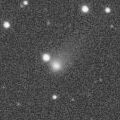
|
Now it is very bright as 12.7 mag (Apr. 12, Marco Goiato). In the Northern Hemisphere, it will be getting lower gradually in the evening sky, and will be unobservable in late July. Then the comet will go southwards, so it will never be observable again in the Northern Hemisphere. In the Southern Hemisphere, it keeps observable in good condition for a long time until autumn.
Date(TT) R.A. (2000) Decl. Delta r Elong. m1 Best Time(A, h)
May 24 11 58.60 -1 26.4 2.507 3.103 117 13.6 19:49 (180, 57)
May 31 11 59.17 -2 30.7 2.572 3.084 110 13.6 19:22 (180, 58)
|
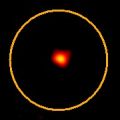
|
It was so faint as 17.2 mag on Apr. 27 (E. Guido, G. Sostero), but brightening very rapidly. Terry Lovejoy reported that it is already very bright as 12-13 mag on May 14. It will be bright at 12 mag until July. However, it keeps locating extremely low for a while in the Northern Hemisphere. It will be getting higher gradually after late July, then it keeps observable while fading gradually.
Date(TT) R.A. (2000) Decl. Delta r Elong. m1 Best Time(A, h)
May 24 0 50.62 0 57.1 1.346 1.063 51 14.2 5:25 (243, 32)
May 31 1 21.64 4 51.2 1.342 1.025 49 13.7 5:29 (240, 29)
|

|
It was 15 mag on Jan. 14 (Michael Mattiazzo), brightening as expected. It will reach to 13.5 mag in the southern sky in spring and summer. In the Southern Hemisphere, it keeps observable for a long time after this. But in the Northern Hemisphere, it is not observable now. But it will appear in the morning sky at 15 mag in November, then it keeps observable while the comet will be fading slowly.
Date(TT) R.A. (2000) Decl. Delta r Elong. m1 Best Time(A, h)
May 24 5 19.44 -41 47.0 2.757 2.502 64 13.7 18:28 ( 58, 30)
May 31 5 43.78 -41 10.7 2.748 2.499 65 13.7 18:26 ( 58, 29)
|
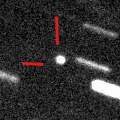
|
Now it is 13.8 mag (May 12, Juan Jose Gonzalez), brightening as expected and already visible visually. It is getting higher gradually in the morning sky. It is expected to reach to 6 mag in 2009 February. After this, it keeps observable until October when it becomes 11 mag.
Date(TT) R.A. (2000) Decl. Delta r Elong. m1 Best Time(A, h)
May 24 21 48.52 -12 16.4 3.060 3.353 97 14.2 5:25 (190, 67)
May 31 21 44.32 -12 33.6 2.856 3.279 105 13.9 5:10 (180, 68)
|

|
After an outburst on Dec. 29, some outbursts occured repeatedly until mid January. It became very bright as 10.4 mag on Jan. 15 (P. Clay Sherrod). Then it is fading gradually. But it was still bright as 12.7 mag on Mar. 5 (Juan Jose Gonzalez). Now it is 13.7 mag (Apr. 4, Carlos Labordena), and extremely diffuse. It will be too low to observe at the end of May.
Date(TT) R.A. (2000) Decl. Delta r Elong. m1 Best Time(A, h)
May 24 6 30.20 27 30.4 6.837 6.023 33 14.0 18:28 (128, 5)
May 31 6 35.80 27 20.6 6.897 6.025 28 14.0 18:26 (125, 1)
|
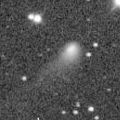
|
Now it is 12.9 mag (Apr. 27, Sandor Szabo and Zoltan Toth), very bright visually. It keeps observable visually at 13 mag at high location for a while.
Date(TT) R.A. (2000) Decl. Delta r Elong. m1 Best Time(A, h)
May 24 16 4.19 21 20.4 4.879 5.671 137 14.6 23:53 (180, 34)
May 31 15 55.46 21 57.3 4.915 5.680 135 14.6 23:17 (180, 33)
|
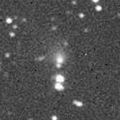
|
It is already bright as 14.7 mag and visible visually (Mar. 5, Seiichi Yoshida). It is expected to reach to 11 mag in 2009 summer. Because it moves in the northern sky, it keeps observable until it becomes brightest in the Northern Hemisphere. But it becomes low from April to June.
Date(TT) R.A. (2000) Decl. Delta r Elong. m1 Best Time(A, h)
May 24 3 38.55 57 0.1 5.688 4.911 36 14.9 5:25 (219,-30)
May 31 3 42.81 57 26.8 5.640 4.865 36 14.8 5:29 (217,-26)
|
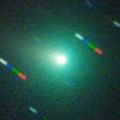
|
It brightened up to 8.3 mag on Feb. 6 (Juan Jose Gonzalez). However, now it is fading and getting diffuse very rapidly. It has already faded down to 14.8 mag (May 18, Ernesto Guido and Giovanni Sostero). It will be too faint to see visually soon. In the Northern Hemisphere, it keeps observable in good condition until July when it becomes fainter than 18 mag.
Date(TT) R.A. (2000) Decl. Delta r Elong. m1 Best Time(A, h)
May 24 9 19.61 27 36.6 1.783 1.742 71 15.0 18:28 (161, 25)
May 31 9 38.70 25 52.2 1.895 1.801 69 15.6 18:26 (159, 26)
|
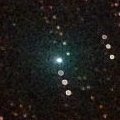
|
It brightened up to 8.5 mag on Jan. 6 (Alexandre Amorim). It kept bright until March, however, now it is getting diffuse and fading rapidly. It has already faded down to 12.0 mag (Mar. 30, Marco Goiato). It will be too low to observe in late May.
Date(TT) R.A. (2000) Decl. Delta r Elong. m1 Best Time(A, h)
May 24 7 0.84 8 3.1 3.281 2.655 44 15.2 18:28 (119, 23)
May 31 7 7.21 9 3.1 3.447 2.738 39 15.4 18:26 (117, 19)
|
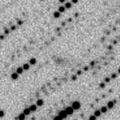
|
It was recovered at 18.7 mag on Mar. 3, as bright as expected (R. E. Hill). Then it is brightening rapidly as expected, and already brightened up to 15.5-16.0 mag (Apr. 14, Michael Jager). It will reach to 15 mag in May. In the Southern Hemisphere, it keeps observable in good condition until it fades out. In the Northern Hemisphere, the condition is bad. It will be too low to observe in mid May.
Date(TT) R.A. (2000) Decl. Delta r Elong. m1 Best Time(A, h)
May 24 22 54.18 -29 49.5 0.321 1.062 90 15.3 5:25 (258, 72)
May 31 23 40.19 -34 47.0 0.357 1.072 89 15.6 5:29 (276, 70)
|
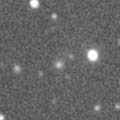
|
Now it is 15.7 mag (May 5, Siding Spring Survey). In the Southern Hemisphere, it keeps 15-16 mag and observable in good condition until summer. In the Northern Hemisphere, it will never be observable again.
Date(TT) R.A. (2000) Decl. Delta r Elong. m1 Best Time(A, h)
May 24 20 49.89 -51 3.4 2.653 3.249 117 15.4 4:43 ( 0, 74)
May 31 20 49.56 -51 16.3 2.625 3.288 122 15.5 4:15 ( 0, 74)
|
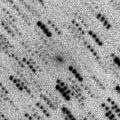
|
Although it had been extremely fainter than expected until March, it brightened very rapidly in April. It became very bright and visible visually at 11.3 mag (Apr. 12, Marco Goiato). However, it was difficult to see because extremely diffuse. CCD observers reported it so faint as 15 mag. This comet tends to be brightest after the perihelion passage. In the Northern Hemisphere, it had been low until March, but now it locates high.
Date(TT) R.A. (2000) Decl. Delta r Elong. m1 Best Time(A, h)
May 24 20 36.14 20 38.2 0.721 1.357 101 15.6 4:29 (180, 34)
May 31 20 37.43 23 17.2 0.743 1.406 105 15.8 4:03 (180, 32)
|
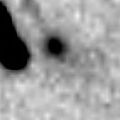
|
Now it is 15.3 mag (May 15, Ken-ichi Kadota). It keeps observable in good condition after this in the Northern Hemisphere. It will be fading gradually, and will be fainter than 18 mag in November.
Date(TT) R.A. (2000) Decl. Delta r Elong. m1 Best Time(A, h)
May 24 22 54.95 15 53.4 2.130 2.071 72 15.8 5:25 (205, 35)
May 31 23 2.25 19 40.5 2.089 2.094 76 15.8 5:29 (197, 34)
|
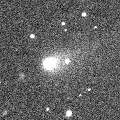
|
It brightned up to 13.4 mag on Jan. 4 (Seiichi Yoshida). Now it is fading. It was still visible visually at 14.4 mag on Mar. 5 (Seiichi Yoshida). But it has already faded down to 15.6 mag (Apr. 6, Ken-ichi Kadota). It will be unobservable in mid June, and the comet will go away.
Date(TT) R.A. (2000) Decl. Delta r Elong. m1 Best Time(A, h)
May 24 8 54.10 9 53.0 3.332 3.138 70 16.1 18:28 (147, 39)
May 31 9 3.12 9 14.2 3.452 3.176 65 16.2 18:26 (142, 38)
|
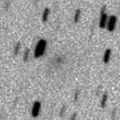
|
It will reach to 16 mag from May to July, and will be observable in good condition.
Date(TT) R.A. (2000) Decl. Delta r Elong. m1 Best Time(A, h)
May 24 17 45.78 83 24.1 1.746 1.781 75 16.2 1:44 (180,-28)
May 31 15 56.16 80 16.0 1.691 1.777 77 16.1 23:11 (180,-25)
|
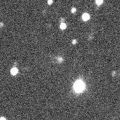
|
Now it is 16.0-16.5 mag (May 22, Michael Jager). It will be observable at 16-17 mag from April to July. It will be fainter than 18 mag in August. It keeps locating in the evening sky all time.
Date(TT) R.A. (2000) Decl. Delta r Elong. m1 Best Time(A, h)
May 24 9 36.12 10 22.9 0.902 1.232 79 16.2 18:28 (160, 43)
May 31 10 0.11 8 10.2 0.907 1.231 79 16.3 18:26 (158, 45)
|
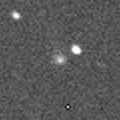
|
Now it is 16.8 mag (Feb. 29, Ken-ichi Kadota). It keeps 16 mag for one year from 2008 spring to 2009 spring. In the Northern Hemisphere, it had been observable in good condition for a long time, but it will be too low to observe in July. Then the comet goes southwards, and it will never observable again, except for locating extremely low in the morning sky from November to December.
Date(TT) R.A. (2000) Decl. Delta r Elong. m1 Best Time(A, h)
May 24 10 53.92 4 25.1 3.668 3.971 99 16.3 18:44 (180, 51)
May 31 10 51.57 3 25.4 3.756 3.943 93 16.3 18:26 (175, 52)
|
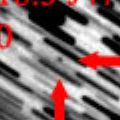
|
Now it is 17.8 mag (May 17, Gustavo Muler). It will be brightening rapidly after this. It will reach up to 9 mag and keep bright for a long time from summer to autumn. In the Northern Hemisphere, it becomes low in the south at brightest, but it keeps observable until it fades out.
Date(TT) R.A. (2000) Decl. Delta r Elong. m1 Best Time(A, h)
May 24 19 0.30 12 7.2 0.832 1.643 125 16.7 2:53 (180, 43)
May 31 19 7.19 13 9.8 0.762 1.602 128 16.4 2:32 (180, 42)
|

|
It is expected to reach up to 7.5 mag in winter, and will be observable in good condition. However, this comet has not been observed since 1986. It is predicted to be already brightening as 17 mag. The condition of this apparition is good. It keeps observable for a long time until 2009 early summer both in the Northern Hemisphere and Southern Hemisphere.
Date(TT) R.A. (2000) Decl. Delta r Elong. m1 Best Time(A, h)
May 24 20 44.29 -22 42.5 2.140 2.735 115 16.9 4:37 (180, 78)
May 31 20 47.27 -22 39.4 1.998 2.673 121 16.5 4:13 (180, 78)
|

|
No observations have been succeeded since 2007 July. Now it is appearing in the morning sky, and it is predicted to be so bright as 14 mag. But actually, it was not detected, fainter than 16.8 mag on Apr. 12 (Esteban Reina Lorenz). It seems to be much fainter than expected. It will be observable in good condition from spring to summer. However, maybe it has already disappeared.
Date(TT) R.A. (2000) Decl. Delta r Elong. m1 Best Time(A, h)
May 24 21 52.95 -0 12.4 1.778 2.087 92 16.8 5:25 (189, 55)
May 31 22 1.52 1 56.5 1.733 2.104 96 16.8 5:26 (180, 53)
|

|
It will be bright at 9-10 mag for a long time from spring to autumn in 2009. Now it is predicted to be so faint as 19 mag. But actually, it is 16-17 mag recently, much brighter than expected. Maybe it is in a temporary outburst.
Date(TT) R.A. (2000) Decl. Delta r Elong. m1 Best Time(A, h)
May 24 9 56.11 15 58.4 3.348 3.371 82 16.9 18:28 (167, 38)
May 31 10 0.19 15 34.5 3.414 3.334 76 16.9 18:26 (161, 37)
|
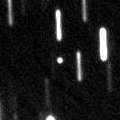
|
Peculiar asteroid moving on a cometary orbit. It reached up to 15.0 mag on Mar. 11 (Katsumi Yoshimoto). It has passed the perihelion in late January, but still completely asteroidal. It is already going away from the sun and fading. In the Northern Hemisphere, it keeps observable until July when it becomes fainter than 18 mag.
Date(TT) R.A. (2000) Decl. Delta r Elong. m1 Best Time(A, h)
May 24 11 27.34 7 46.8 1.698 2.208 106 17.1 19:18 (180, 47)
May 31 11 36.91 8 10.1 1.816 2.251 101 17.2 19:00 (180, 47)
|
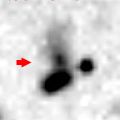
|
Now it is 17.2 mag (May 10, Gustavo Muler). It keeps observable while the comet will be brightening gradually after this. It will reach up to 14.5 mag in autumn. However, then it locates low in the evening sky, and it will be unobservable soon in December.
Date(TT) R.A. (2000) Decl. Delta r Elong. m1 Best Time(A, h)
May 24 15 50.47 -4 28.7 1.904 2.889 163 17.3 23:40 (180, 59)
May 31 15 44.82 -3 58.2 1.876 2.844 158 17.1 23:07 (180, 59)
|
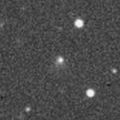
|
Now it is 16.0-16.5 mag (May 22, Michael Jager), brightened as expected. After this, it will be getting fainter slowly and getting lower slowly in the evening sky.
Date(TT) R.A. (2000) Decl. Delta r Elong. m1 Best Time(A, h)
May 24 10 52.27 27 24.7 2.242 2.469 90 17.1 18:43 (180, 28)
May 31 10 59.59 25 56.0 2.318 2.469 86 17.2 18:26 (179, 29)
|
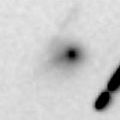
|
Gustavo Muler reported that it became so bright as 14-15 mag on May 23, much brighter than this ephemeris. Maybe in an outburst. The original prediction says that it will reach to 14 mag in autumn, but it locates extremely low in the Northern Hemisphere. However, it keeps higher than 30 degree even in the Northern Hemisphere until August.
Date(TT) R.A. (2000) Decl. Delta r Elong. m1 Best Time(A, h)
May 24 10 41.29 35 37.1 1.696 1.901 85 17.3 18:32 (180, 20)
May 31 10 48.43 33 52.5 1.710 1.848 81 17.2 18:26 (177, 21)
|
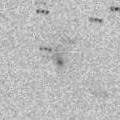
|
Now it is 16.5 mag (Apr. 22, Ken-ichi Kadota). It keeps observable in good condition while the comet will be fading slowly.
Date(TT) R.A. (2000) Decl. Delta r Elong. m1 Best Time(A, h)
May 24 13 16.74 68 44.1 2.739 2.846 85 17.2 21:06 (180,-13)
May 31 13 4.83 65 10.1 2.780 2.863 84 17.3 20:27 (180,-10)
|
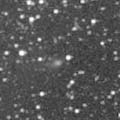
|
Now it is brightest at 17 mag. But it will be fading gradually, and it will be fainter than 18 mag in July.
Date(TT) R.A. (2000) Decl. Delta r Elong. m1 Best Time(A, h)
May 24 14 37.02 -13 16.2 3.238 4.193 157 17.3 22:26 (180, 68)
May 31 14 24.66 -12 44.3 3.332 4.228 148 17.4 21:46 (180, 68)
|
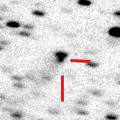
|
It was observed at 16.5-17 mag in 2006 and 2007. Because it is a very distant comet, it is observable at 17 mag still in 2008 in good condition.
Date(TT) R.A. (2000) Decl. Delta r Elong. m1 Best Time(A, h)
May 24 19 23.65 39 54.4 5.932 6.248 103 17.3 3:17 (180, 15)
May 31 19 17.07 41 1.6 5.903 6.265 106 17.3 2:43 (180, 14)
|

|
It had been observed at 16.5 mag for a long time from 2005 to 2007. Now it is fading. But it keeps observable at 17.5 mag in good condition for a long time until July.
Date(TT) R.A. (2000) Decl. Delta r Elong. m1 Best Time(A, h)
May 24 13 57.56 15 12.0 7.906 8.623 132 17.5 21:47 (180, 40)
May 31 13 54.90 14 49.2 8.005 8.649 126 17.5 21:17 (180, 40)
|

|
Although it was so faint as 20 mag still in January, it brightened rapidly and reached up to 17.1 mag now (May 15, Yasukazu Ikari). It is observable in good condition until summer.
Date(TT) R.A. (2000) Decl. Delta r Elong. m1 Best Time(A, h)
May 24 14 41.97 2 5.3 2.818 3.727 149 17.8 22:32 (180, 53)
May 31 14 38.55 1 57.2 2.861 3.723 143 17.8 22:01 (180, 53)
|

|
It will approach to the sun down to 0.1 A.U. on June 17. It moves very fast in the northern sky in May. It is observable at 16 mag in good condition in first half of May in the Northern Hemisphere. It passes near by Polaris in mid May, and it will be unobservable at the end of May. If it shows a cometary activity, it may become much brighter than this ephemeris.
Date(TT) R.A. (2000) Decl. Delta r Elong. m1 Best Time(A, h)
May 24 5 13.88 52 30.4 0.284 0.795 34 20.3 18:28 (138,-22)
May 31 5 7.79 37 20.3 0.422 0.623 17 23.2 18:26 (122,-19)
|
|
![]()
 C/2006 OF2 ( Broughton )
C/2006 OF2 ( Broughton ) C/2007 G1 ( LINEAR )
C/2007 G1 ( LINEAR ) 8P/Tuttle
8P/Tuttle C/2008 J1 ( Boattini )
C/2008 J1 ( Boattini ) C/2008 J4 ( McNaught )
C/2008 J4 ( McNaught ) P/2008 J2 ( Beshore )
P/2008 J2 ( Beshore ) C/2007 B2 ( Skiff )
C/2007 B2 ( Skiff ) 15P/Finlay
15P/Finlay C/2006 U6 ( Spacewatch )
C/2006 U6 ( Spacewatch ) C/2007 N3 ( Lulin )
C/2007 N3 ( Lulin ) 29P/Schwassmann-Wachmann 1
29P/Schwassmann-Wachmann 1 C/2005 L3 ( McNaught )
C/2005 L3 ( McNaught ) C/2006 W3 ( Christensen )
C/2006 W3 ( Christensen ) 46P/Wirtanen
46P/Wirtanen C/2007 T1 ( McNaught )
C/2007 T1 ( McNaught ) 197P/2008 E2 ( LINEAR )
197P/2008 E2 ( LINEAR ) C/2006 V1 ( Catalina )
C/2006 V1 ( Catalina ) 26P/Grigg-Skjellerup
26P/Grigg-Skjellerup C/2008 J6 ( Hill )
C/2008 J6 ( Hill ) C/2006 S5 ( Hill )
C/2006 S5 ( Hill ) C/2007 W3 ( LINEAR )
C/2007 W3 ( LINEAR ) 79P/du Toit-Hartley
79P/du Toit-Hartley C/2007 M2 ( Catalina )
C/2007 M2 ( Catalina ) 6P/d'Arrest
6P/d'Arrest 85P/Boethin
85P/Boethin C/2007 K3 ( Siding Spring )
C/2007 K3 ( Siding Spring ) 22P/Kopff
22P/Kopff 2005 WY3
2005 WY3 68P/Klemola
68P/Klemola 180P/2006 U3 ( NEAT )
180P/2006 U3 ( NEAT ) 7P/Pons-Winnecke
7P/Pons-Winnecke C/2008 H1 ( LINEAR )
C/2008 H1 ( LINEAR ) C/2007 M3 ( LINEAR )
C/2007 M3 ( LINEAR ) C/2005 S4 ( McNaught )
C/2005 S4 ( McNaught ) C/2002 VQ94 ( LINEAR )
C/2002 VQ94 ( LINEAR ) 187P/2007 E3 ( LINEAR )
187P/2007 E3 ( LINEAR ) 2008 HW1
2008 HW1![]()



































